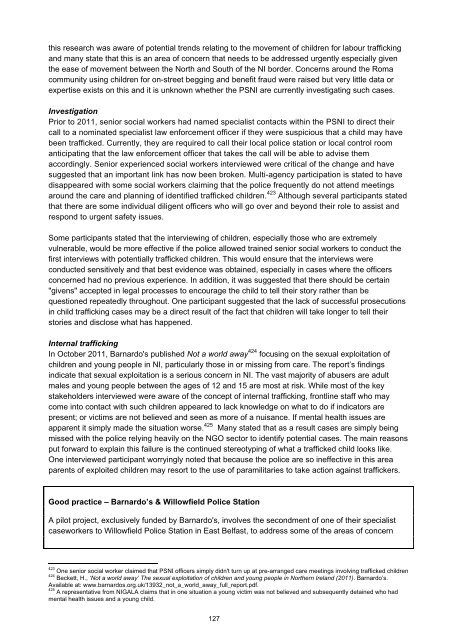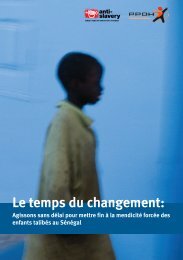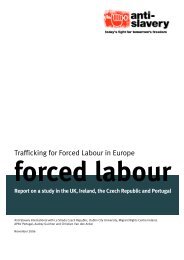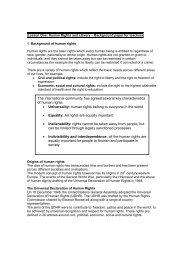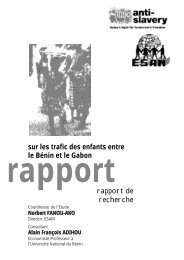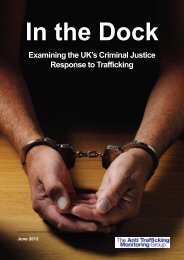In the Dock
Full report (1810.59KB) - Anti-Slavery International
Full report (1810.59KB) - Anti-Slavery International
Create successful ePaper yourself
Turn your PDF publications into a flip-book with our unique Google optimized e-Paper software.
this research was aware of potential trends relating to <strong>the</strong> movement of children for labour traffickingand many state that this is an area of concern that needs to be addressed urgently especially given<strong>the</strong> ease of movement between <strong>the</strong> North and South of <strong>the</strong> NI border. Concerns around <strong>the</strong> Romacommunity using children for on-street begging and benefit fraud were raised but very little data orexpertise exists on this and it is unknown whe<strong>the</strong>r <strong>the</strong> PSNI are currently investigating such cases.<strong>In</strong>vestigationPrior to 2011, senior social workers had named specialist contacts within <strong>the</strong> PSNI to direct <strong>the</strong>ircall to a nominated specialist law enforcement officer if <strong>the</strong>y were suspicious that a child may havebeen trafficked. Currently, <strong>the</strong>y are required to call <strong>the</strong>ir local police station or local control roomanticipating that <strong>the</strong> law enforcement officer that takes <strong>the</strong> call will be able to advise <strong>the</strong>maccordingly. Senior experienced social workers interviewed were critical of <strong>the</strong> change and havesuggested that an important link has now been broken. Multi-agency participation is stated to havedisappeared with some social workers claiming that <strong>the</strong> police frequently do not attend meetingsaround <strong>the</strong> care and planning of identified trafficked children. 423 Although several participants statedthat <strong>the</strong>re are some individual diligent officers who will go over and beyond <strong>the</strong>ir role to assist andrespond to urgent safety issues.Some participants stated that <strong>the</strong> interviewing of children, especially those who are extremelyvulnerable, would be more effective if <strong>the</strong> police allowed trained senior social workers to conduct <strong>the</strong>first interviews with potentially trafficked children. This would ensure that <strong>the</strong> interviews wereconducted sensitively and that best evidence was obtained, especially in cases where <strong>the</strong> officersconcerned had no previous experience. <strong>In</strong> addition, it was suggested that <strong>the</strong>re should be certain"givens" accepted in legal processes to encourage <strong>the</strong> child to tell <strong>the</strong>ir story ra<strong>the</strong>r than bequestioned repeatedly throughout. One participant suggested that <strong>the</strong> lack of successful prosecutionsin child trafficking cases may be a direct result of <strong>the</strong> fact that children will take longer to tell <strong>the</strong>irstories and disclose what has happened.<strong>In</strong>ternal trafficking<strong>In</strong> October 2011, Barnardo's published Not a world away 424 focusing on <strong>the</strong> sexual exploitation ofchildren and young people in NI, particularly those in or missing from care. The report’s findingsindicate that sexual exploitation is a serious concern in NI. The vast majority of abusers are adultmales and young people between <strong>the</strong> ages of 12 and 15 are most at risk. While most of <strong>the</strong> keystakeholders interviewed were aware of <strong>the</strong> concept of internal trafficking, frontline staff who maycome into contact with such children appeared to lack knowledge on what to do if indicators arepresent; or victims are not believed and seen as more of a nuisance. If mental health issues areapparent it simply made <strong>the</strong> situation worse. 425 Many stated that as a result cases are simply beingmissed with <strong>the</strong> police relying heavily on <strong>the</strong> NGO sector to identify potential cases. The main reasonsput forward to explain this failure is <strong>the</strong> continued stereotyping of what a trafficked child looks like.One interviewed participant worryingly noted that because <strong>the</strong> police are so ineffective in this areaparents of exploited children may resort to <strong>the</strong> use of paramilitaries to take action against traffickers.Good practice – Barnardo’s & Willowfield Police StationA pilot project, exclusively funded by Barnardo's, involves <strong>the</strong> secondment of one of <strong>the</strong>ir specialistcaseworkers to Willowfield Police Station in East Belfast, to address some of <strong>the</strong> areas of concern423One senior social worker claimed that PSNI officers simply didn't turn up at pre-arranged care meetings involving trafficked children424Beckett, H., ‘Not a world away’ The sexual exploitation of children and young people in Nor<strong>the</strong>rn Ireland (2011). Barnardo’s.Available at: www.barnardos.org.uk/13932_not_a_world_away_full_report.pdf.425A representative from NIGALA claims that in one situation a young victim was not believed and subsequently detained who hadmental health issues and a young child.127


